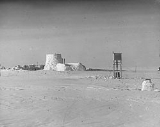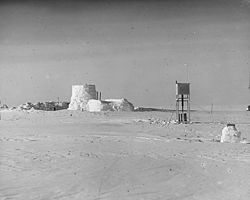
Eismitte
Encyclopedia

English language
English is a West Germanic language that arose in the Anglo-Saxon kingdoms of England and spread into what was to become south-east Scotland under the influence of the Anglian medieval kingdom of Northumbria...
also called Mid-Ice, was the site of an Arctic
Arctic
The Arctic is a region located at the northern-most part of the Earth. The Arctic consists of the Arctic Ocean and parts of Canada, Russia, Greenland, the United States, Norway, Sweden, Finland, and Iceland. The Arctic region consists of a vast, ice-covered ocean, surrounded by treeless permafrost...
expedition in the interior of Greenland
Greenland
Greenland is an autonomous country within the Kingdom of Denmark, located between the Arctic and Atlantic Oceans, east of the Canadian Arctic Archipelago. Though physiographically a part of the continent of North America, Greenland has been politically and culturally associated with Europe for...
that took place from July 1930 through August 1931, and claimed the life of noted German
Germany
Germany , officially the Federal Republic of Germany , is a federal parliamentary republic in Europe. The country consists of 16 states while the capital and largest city is Berlin. Germany covers an area of 357,021 km2 and has a largely temperate seasonal climate...
scientist Alfred Wegener
Alfred Wegener
Alfred Lothar Wegener was a German scientist, geophysicist, and meteorologist.He is most notable for his theory of continental drift , proposed in 1912, which hypothesized that the continents were slowly drifting around the Earth...
.
The name "Eismitte" means Ice-Center in German
German language
German is a West Germanic language, related to and classified alongside English and Dutch. With an estimated 90 – 98 million native speakers, German is one of the world's major languages and is the most widely-spoken first language in the European Union....
, and the campsite was located 402 kilometres (249.8 mi) from the coast at an estimated altitude of 3,000 meters (9,843 feet). The coldest temperature
Temperature
Temperature is a physical property of matter that quantitatively expresses the common notions of hot and cold. Objects of low temperature are cold, while various degrees of higher temperatures are referred to as warm or hot...
recorded during the expedition was −64.9 °C (−85 °F), while the warmest temperature noted was −2.8 °C (27 °F). For the 12-month period beginning September 1, 1930 and ending August 31, 1931, the warmest month, July, had a mean monthly temperature of −12.2 °C (10 °F), while the coldest month, February, averaged −47.2 °C (−53 °F). Over the same period a total of 110 millimeters (4.33 inches) of water-equivalent precipitation
Precipitation (meteorology)
In meteorology, precipitation In meteorology, precipitation In meteorology, precipitation (also known as one of the classes of hydrometeors, which are atmospheric water phenomena is any product of the condensation of atmospheric water vapor that falls under gravity. The main forms of precipitation...
was recorded, with most of it, rather surprisingly, being received in winter. At the latitude of the camp, the sun does not set between May 13 and July 30 each year, and does not rise between November 23 and January 20.
External links
- Hourly meteorological observations at station Eismitte by Johannes Georgi .

